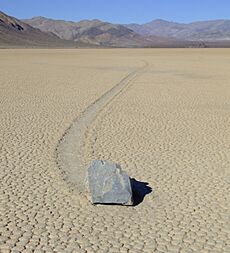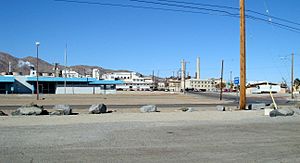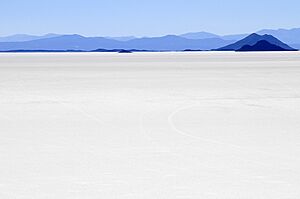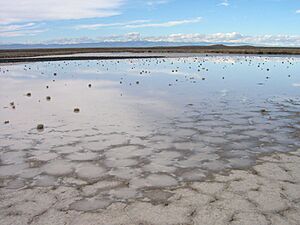Dry lake facts for kids
Imagine a huge, flat area that looks like a lake, but it's completely dry! This is called a dry lake bed or playa. It's a natural dip in the ground that once held water, like a pond or lake. However, over time, more water evaporated than flowed in, leaving the basin dry.
Sometimes, the floor of a dry lake is covered with white, powdery alkaline compounds. Then it's known as an alkali flat. If it's covered with a thick layer of salt, it's called a salt flat or salt pan. These fascinating places are found in many dry parts of the world.
Contents
Discovering Dry Lake Beds
What Are Dry Lake Beds?
A dry lake bed is essentially a large, flat area of land. It used to be covered by water, but now it's mostly dry. These areas are often found in deserts or very dry regions. The water that once filled them has evaporated, leaving behind a unique landscape.
Different Names for Dry Lakes
Dry lake beds have many names around the world! In some parts of Mexico and the western United States, they are often called playas. This Spanish word actually means "beach". You might hear this term used in places like the Llano Estacado.
If a dry lake bed is mostly made of salt, it's called a salt pan or salt flat. In South America, especially in countries like Bolivia, these salty areas are known as salar or salina. In South Africa, they are simply called pans. Australia has salt pans and clay pans. In Arabic-speaking regions, a salt flat might be called a sabkha or shott. In Iran, they are known as kavir.
How Dry Lakes Form

Dry lakes form when water flows into a natural dip in the land. This water can come from rain or even from underground sources. It creates a temporary pond or lake. But in dry areas, the sun and wind cause a lot of evaporation. If more water evaporates each year than flows in, the lake eventually dries up.
When the water disappears, it leaves behind all the salts and minerals that were dissolved in it. Over many years, these minerals build up, creating the flat, often salty, surface we see today. Dry lakes usually have a flat bed of clay, often covered with a crust of these evaporated salts.
Most dry lakes are small. However, some are enormous! The Salar de Uyuni in Bolivia is the world's largest salt flat. It covers an amazing 4,085 square miles (10,582 square kilometers). That's bigger than some countries! The southern High Plains of Texas and eastern New Mexico have the most dry lakes, with nearly 22,000 of them.
Many dry lakes get a thin layer of water during the rainy season. If this water is shallow and moved by the wind, it can create a very smooth, hard surface. If there's more water, the surface might dry into a "cracked-mud" pattern. Sometimes, if there's very little water, sand dunes can even form.
The Magic of Sailing Stones
One of the most amazing things about dry lakes happens at Racetrack Playa in Death Valley, California. Here, rocks seem to move all by themselves, leaving long tracks behind them! These are called "sailing stones". For a long time, no one knew how they moved.
Scientists from the Scripps Institution of Oceanography at the University of California, San Diego recently filmed these rocks in action. They discovered it's a perfect mix of events. First, the playa needs to fill with enough water to form ice in winter. The ice must be thick enough to be strong, but thin enough to float. When the sun warms up, the ice melts and cracks into large floating panels. Light winds then push these ice panels, which in turn push the rocks across the playa! This incredible movement only happens every few years.
Life in and Around Dry Lakes
While the very center of a dry lake might not have much plant life, the edges are often full of special plants. These include shadscale and saltbrush. These plants are amazing because they can handle salty soil. They provide important food for animals like livestock and other plant-eating creatures, especially in winter.
Unique Plants and Animals
Some dry lakes are home to very rare animals and plants that live nowhere else! For example, in parts of Idaho, Nevada, and Utah, scientists found a new species of giant fairy shrimp in 2006. These tiny creatures can survive for years as tiny, hidden cysts in the dry lake bed. They only hatch when conditions are just right, after the playa fills with water.
Another special plant is Lepidium davisii, also known as Davis' peppergrass. This plant only grows in playas in southern Idaho and northern Nevada. For desert wildlife like antelope, dry lakes are often the only source of water after a rainstorm.
Protecting These Special Places
Dry lakes face some challenges. They can be affected by pollution from farms and livestock operations. This can lead to erosion and runoff of fertilizers and other materials. Also, some non-native plants, like Kochia prostrata, can grow too much. They can crowd out native plants and even dry up the playa's water with their roots. It's important to protect these unique habitats.
How People Use Dry Lakes

The super flat, smooth, and hard surfaces of dry lake beds make them perfect for certain activities.
Speed Records and Airfields
Many people use large dry lakes for racing fast cars and motorcycles. The smooth surface means vehicles can go incredibly fast without bumps or obstacles. Famous places for setting land speed records include the Bonneville Salt Flats in Utah and the Black Rock Desert in Nevada. Lake Eyre in South Australia has also hosted speed attempts.
Because they are so flat and open, dry lake beds that rarely fill with water are sometimes used as air bases. For example, Edwards Air Force Base in California (originally Muroc Dry Lake) and Groom Lake at Area 51 in Nevada are built on dry lake beds.
Valuable Minerals and Resources
Underneath some dry lakes, there are valuable minerals dissolved in underground salty water, called brines. Companies can extract these minerals. For instance, Searles Dry Lake is used to get minerals like trona. The Salar de Uyuni in Bolivia is a major source of lithium, a key ingredient for batteries.
Lakes Around the World Are Shrinking
Sadly, many large lakes around the world are shrinking. A study in 2023 by Fangfang Yao and colleagues at the University of Virginia found that over half of the world's large lakes are drying up. They looked at nearly 2,000 lakes using satellite data. They discovered that human activities, changes in rainfall, and rising temperatures have caused lake levels to drop globally. From 1992 to 2020, 53% of these lakes showed a decline. This shows how important it is to understand and protect our water resources, including dry lakes.
Images for kids
-
Devil's Golf Course in Death Valley National Park, western United States
-
The dry lake and shore of Lake Hart, an endorheic desert lake in South Australia. -
Etosha pan in northern Namibia
See also
- List of drying lakes
- Lake
- Cienega
- Salt storm
- Soil salinity







